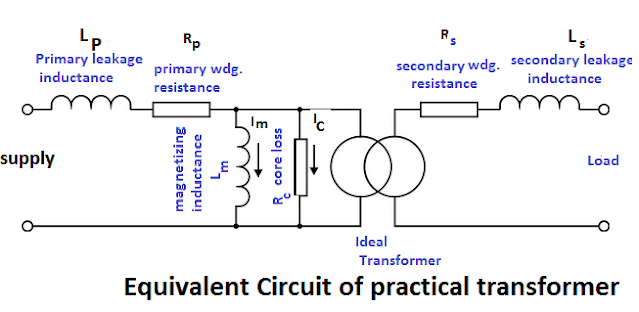The no-load current of a transformer is the vector sum of the exciting current and core loss current of the transformer.
Why Losses in a Transformer?
To understand the meaning of these currents in a transformer, it may be helpful to study the equivalent circuit of a single-phase transformer. An ideal transformer is a transformer that has zero loss, however, the practical transformer has some losses because the magnetic field is not concentrated in the magnetic core, and some of the flux leaks from the core. As a result, the core losses occur in the transformer.
The equivalent circuit of the transformer is as given below.
The current components which cause losses in the transformer are the magnetizing inductance Lm and the core loss path Rc. These two components receive the full supply even when the transformer is at no load. The loss caused by these components at no load is called no-load or core loss.
The no-load current is the vector sum of exciting current and core loss current. To understand the difference between no-load & exciting current, first, we will understand what is the exciting current and what is the core loss current.
What is Exciting or Magnetizing current?
The magnetizing inductance draws magnetizing current Im which sets up the flux in the transformer core. We call magnetizing current Im as excitation (exciting) current.
The exciting current or magnetizing current set up the flux in the core and the flux links to the primary and secondary of the transformer winding. As a result, the transformer transfers the electrical energy from the primary side to the secondary side of the transformer.
The magnetizing current is quite small compared to the full load current of the transformer. In addition to this, the magnetizing current remains constant irrespective of secondary load. The magnetizing current lags the voltage by 90 degrees.
What is core loss current component?
The core loss current Ic in a parallel path through Rc, the Rc represents the core loss of the transformer. The power dissipated in Rc (= Ic2 * Rc), and it represents power loss in the core.
This power loss is the sum of the hysteresis loss and eddy current loss. The core loss depends on the supply voltage. The eddy current and hysteresis loss remains fairly constant if the supply voltage and frequency are constant and it does not depend on the load on secondary. The core loss current is in phase with the primary voltage.
What is no load current of transformer?
Therefore, the no-load current is the (vector) sum of the exciting current and the core loss current. The core loss current and magnetizing current are 90 degrees out of phase with each other.
These current components are vector quantity and the resultant of both the current can not be found by simple addition, but the Pythagoras’ theorem for right-angle triangles can be used to find the resultant current
What is leakage current in transformer?
Leakage current is current which flows from the transformer winding to the ground. The leakage current flows in the transformer in two ways.
- Leakage current through winding to insulation and to ground
- Leakage current through winding to winding and winding to the core.
The leakage current depends on the quality of the insulation. Therefore, the transformer insulation is an important factor for deciding the magnitude of the leakage current. If transformer insulation is in good condition this insulation leakage current should be infinitesimal. The leakage current can be measured by doing the insulation test between winding and ground on the transformer.
The second path of leakage current is through capacitive coupling between both winding and the core. The magnitude of the leakage current is quite significant because the winding has minimum clearance from the core. The minimum clearance between core and winding reduces the leakage inductance.

1 thought on “Difference between no load, exciting, and leakage current in transformer”